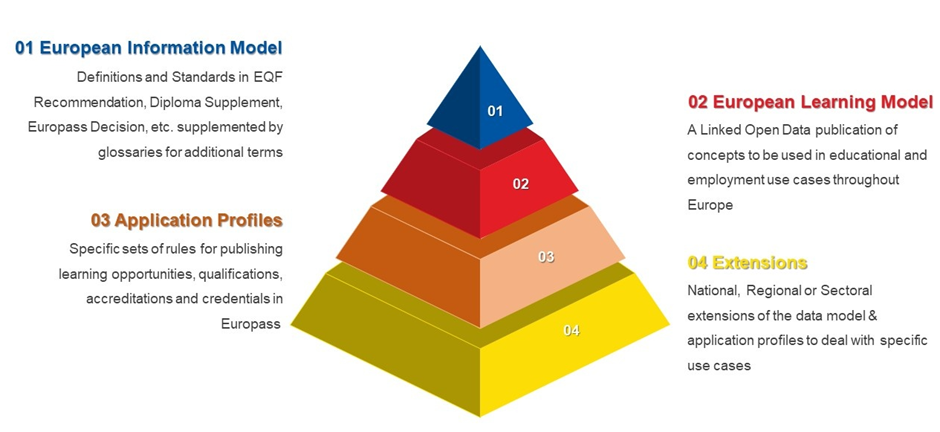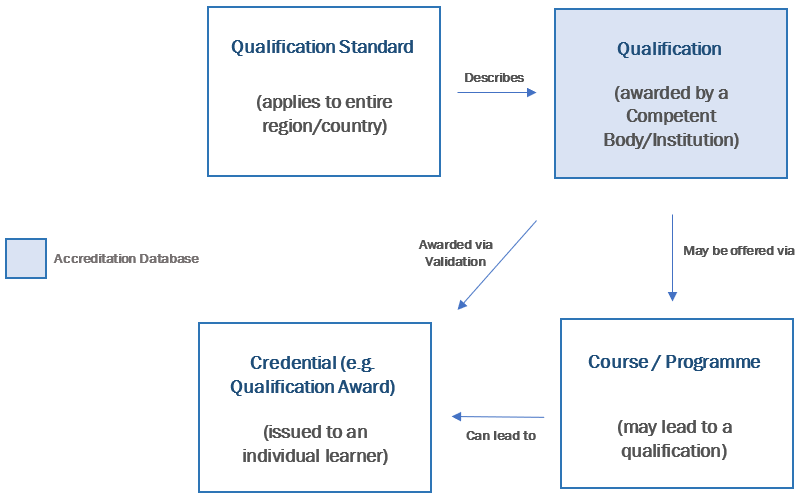Publish your data using the European Learning Model
Data published to the QDR must be published using the European Learning Model (ELM). Learn more about the ELM here.
The European Learning Model (ELM) is the first data model that provides a vocabulary to describe all stages of the learning lifecycle.
- It is intended to harmonise disparate data models across the continent, providing for the description of all types of learning (g., primary, secondary or tertiary, Vocational Education and Training (VET), adult learning), independently from their size (e.g. short workshops to full degree programmes) or source (small training organisations to accredited education providers).
- It can be applied to any educational process, whether regulated or ’open’
- It is a versatile model that can structure data on qualifications, accreditations, learning opportunities and digital credentials.
- The model is a foundational instrument of the skills and qualifications data space. Published as linked open data, it allows for data to be published as knowledge graphs and connected to other datasets and concepts throughout the space.
It is available in 29 languages
The European Learning Model can be described as follows:
- All definitions for educational and employment-related terms in the EQF Annex VI, Commission Communications, Council Recommendations, CEDEFOP and EURYDICE publications, etc,
- A linked open data profile which organises these terms into a single digital terminology and vocabulary,
- A set of application profiles that defines which terms should be used in different contexts (such as for describing qualifications, issuing credentials, describing accreditation, etc),
- Extensions that have been linked to the model, to add national or sectoral context.
The ELM describes the governance system, the standards, related documentation as well as IT services that support the model.
The European Learning Model is the data model used for all learning concepts in Europass, including qualifications, learning opportunities, credentials, and accreditations. The data model ensures a common understanding and consistent use of quality data by all stakeholders involved in the publication and use of data in Europass.
You can explore the European Learning Model in the ELM datamodel browser.
When publishing to the QDR, you will make use of the LOQ (Learning Opportunities and Qualifications) and/or the Accreditation Application Profiles.
- LOQ Application Profile: Providing information about Learning Opportunities and Qualifications. The ELM allows for the record of information in a unified way. Information about learning opportunities and qualifications, including the description of qualification standards, can be used for course catalogues, training announcements and learning opportunity databases, allowing universally comprehensible data to be easily exported and described in the same way across borders.
- Accreditation Application Profile: Publishing information on licensing and accreditation of educational institutions and/or their programmes, as well as issuing accreditation credentials to licenced or accredited organisations.
You can find more documentation on the Application Profiles in the ELM Data Model Browser or in our Document Library.
Since its launch in April 2023, the European Learning Model version 3 (ELM v3) is the main data model supported in QDR, covering both qualifications and learning opportunity data through the LOQ application profile. While an automatic conversion to ELM v3 is currently performed for data provided in QMS2 and LOMS, data submitted using older data models (EQF/QMS1/Ploteus) are no longer supported by QDR and are not visible in the course search on Europass.
Since the release of ELM v3, there have been no significant updates, and this version is now supported long-term by the European Commission. We therefore strongly encourage all stakeholders to adopt the latest version to ensure compatibility and future readiness. The QDR support team only provides assistance for publishing data in ELM v3 format.
The images below indicate the evolution of the data models for publishing qualifications and learning opportunities. ELM has been built on the Ploteus data model, progressively adding interoperability standards and extending to all Europass learning use cases. By adding application profiles and integrating them under one model, the European Learning Model (ELM) v3.0 was created.

Before ELM v3, each application profile was effectively a different data model. The model used more or less the same classes and properties but these were not formally related. This meant that changes were managed individually and manually, and were not always replicated across all application profiles, which resulted in inconsistencies between data models. With one data model to serve as foundation to all the application profiles, the Ontology provides a standardised vocabulary for the whole united model. This means that changes made in the ontology automatically propagate to all the application profiles.
To make these model developments more transparent and understandable, the versioning strategy for ELM has also been enhanced. Each version is now published under standardised addresses and made accessible through the EU Publications Office. By default, the ELM Browser displays the latest version of both the Ontology and the Application Profiles, while also offering the option to explore earlier versions for reference.
The introduction of the versioning strategy entails an update of namespace information in data published to the QDR.

As part of continuous improvements, a minor update has been introduced with the transition to ELM v3.3. To remain compliant, all datasets will require a small but necessary adjustment: the URI header in each dataset must be updated. From January 2026, countries publishing in the latest ELM format need to ensure that the URI header in their LOQ/AMS datasets reflects this change.
Header before the update:
xmlns:elm="http://data.europa.eu/snb/model/elm/"
xmlns:loq="http://data.europa.eu/snb/model/ap/loq-constraints/"
xmlns="http://data.europa.eu/snb/model/ap/loq-constraints/"
xsi:schemaLocation="http://data.europa.eu/snb/model/ap/loq-constraints/ loq.xsd"
Header after the update:
xmlns:elm="http://data.europa.eu/snb/model/ontology/"
xmlns:loq="http://data.europa.eu/snb/model/application-profile/loq-constraints/"
xmlns="http://data.europa.eu/snb/model/application-profile/loq-constraints/"
xsi:schemaLocation="http://data.europa.eu/snb/model/application-profile/loq-constraints/ loq.xsd"
The following graph explains how these different sources of data (learning opportunities, qualifications, accreditations data and credentials) come together in Europass:
A qualification does not necessarily have to be obtained only through a learning opportunity, it could also be awarded through validation.
The 2012 Council recommendation on validation encourages Member States to put in place national arrangements for validation by 2018. These arrangements will enable individuals to increase the visibility and value of their knowledge, skills and competences acquired outside formal education and training: at work, at home, or in voluntary activities.
The European Guidelines on validation provide policy and practical advice to policymakers and stakeholders on implementing validation.
As explained in the Sunset Strategy, data in the latest formats QMS2 / LOMS were migrated automatically, therefore, no immediate action was required. Since April 2023, the QDR has been exclusively supporting ELM v3.
To prepare your data in ELM v3, there are several scenarios depending on how the new data format can impact the publication process in Europass:
- I have already published data on learning opportunities or qualifications via the QDR, but in a legacy format (Ploteus or QMS1)
The QDR Support team is not able to convert your data in ELM that is provided in the old data formats such as EQF, Ploteus, or QMS1. This means that your data cannot be shown in Europass anymore if you do not switch to the newest data format. The countries concerned were informed and invited to an info session that took place in August 2022. The Support team remains available for support during the transition period to ELM v3.
- I have already published data on learning opportunities or qualifications in the most recent data schemes (QMS2 and LOMS)
From QMS2 and LOMS, it was possible to move to ELM v3. This move from QMS2 or LOMS to ELM v3 could be done directly in QDR.
If you are planning to publish your data in ELM V3, get in touch with the ELM Support Team: EMPL-ELM-SUPPORT@ec.europa.eu
The publication process may appear daunting from an outsider’s perspective. However, the following steps can help clarify the sequence of actions to carry out to publish data on learning opportunities in Europass. It is highly recommended to contact the QDR technical team as early as possible, as the team may provide help in the mapping of the data.
*Regarding step 3: the QDR technical team summarised the following process to prepare for ELM V3 and data to send to the QDR. This process is further explained in the Publish your data to the QDR
For additional information about the ELM, you can consult our Introduction to the ELM .
For any further questions, do not hesitate to contact us at EMPL-ELM-SUPPORT@ec.europa.eu



 Facebook
Facebook
 Twitter
Twitter
 Linkedin
Linkedin